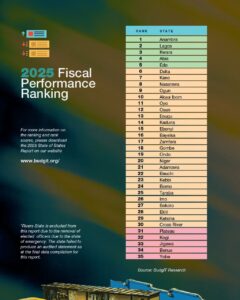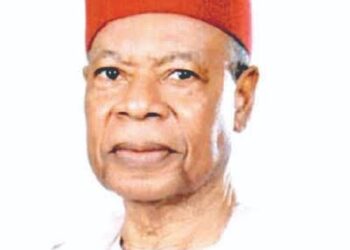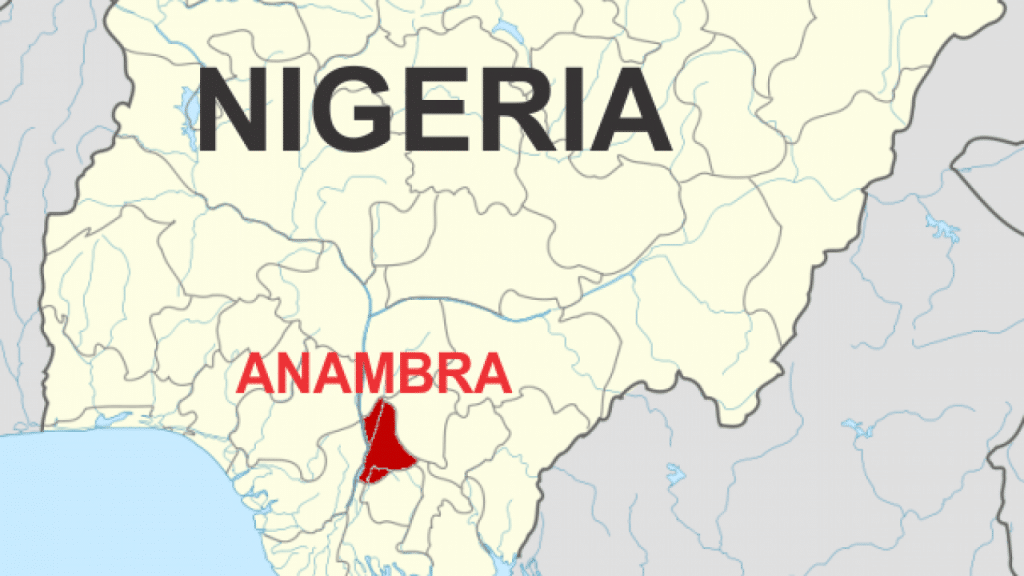Anambra State has been ranked as Nigeria’s best-performing state in the 2025 Fiscal Performance Ranking, according to BudgIT’s State of States Report released on Tuesday.
Lagos, Kwara, Abia, and Edo followed in the top five, while Cross River experienced a major decline, dropping from fifth place in 2024 to 30th in 2025.
Rivers State, previously a consistent top-five performer, was excluded from the 2025 report following a state of emergency declared earlier in the year, which prevented the release of its audited financial data.
 In a statement shared on X (formerly Twitter), BudgIT described this year’s edition titled “A Decade of Subnational Fiscal Analysis: Growth, Decline, and Middling Performance” as a milestone marking ten years of tracking fiscal sustainability and governance transparency across Nigeria’s 36 states.
In a statement shared on X (formerly Twitter), BudgIT described this year’s edition titled “A Decade of Subnational Fiscal Analysis: Growth, Decline, and Middling Performance” as a milestone marking ten years of tracking fiscal sustainability and governance transparency across Nigeria’s 36 states.
Key Movements in the 2025 Rankings
BudgIT highlighted major changes in state performance:
“Anambra State rose from second to first position, securing the title of Nigeria’s best-performing state, while Lagos maintained its second-place ranking for the second consecutive year.

Kwara climbed from fourth to third, Edo entered the top five after consistently ranking within the top ten over the past four editions, and Abia—appearing in the top ten for the first time—secured fourth place,” the organisation stated.
Other notable improvements include Akwa Ibom, which jumped 17 places from 27th to 10th, and Zamfara, which advanced nine spots from 26th to 17th.
At the lower end of the table, Imo, Kogi, Jigawa, Benue, and Yobe occupied the bottom five positions.
Ranking Criteria
The 2025 report assessed 35 states across five core fiscal indicators:Index A , Ability to meet operating expenses using only Internally Generated Revenue (IGR),Index A1 Year-on-year IGR growth rate, Index B – Capacity to cover total expenses and loan obligations using total revenue without borrowing,Index C – Debt sustainability, measured by foreign debt as a percentage of total debt, total debt as a percentage of revenue, debt service as a percentage of revenue, and personnel cost as a percentage of revenue and Index D Prioritisation of capital expenditure over recurrent expenditure.
Revenue and IGR Performance
BudgIT reported significant shifts in states’ revenue profiles.
In 2024, Rivers (121.26%) and Lagos (118.39%) were the only states able to cover their operating expenses entirely with IGR. However, Rivers’ exclusion from the 2025 analysis altered the fiscal landscape.
“Lagos remains a consistent top performer with 120.87%, while Enugu now leads the IGR-to-operating-expense ratio with an impressive 146.68%,” BudgIT reported.
Only five states—Abia, Anambra, Kwara, Ogun, and Edo—generated enough IGR to cover at least 50% of their operating expenses, compared with six in 2024.
Meanwhile, 14 states now require more than five times their IGR to meet operating costs, up from six in 2024—underscoring deep fiscal fragility and overdependence on federal transfers.
Capital and Recurrent Expenditure
Abia State led all states in capital expenditure, allocating 77.05% of its total budget to capital projects. Anambra, Enugu, Ebonyi, and Taraba also devoted over 70% to capital spending.
In total, 24 states spent at least half of their budgets on capital projects—an improvement over previous years. Conversely, Bauchi, Ekiti, Delta, Benue, Oyo, and Ogun allocated more than 60% of their budgets to personnel and overhead costs, indicating inefficiencies in fiscal prioritisation.
Revenue Growth and Federal Transfers
Aggregate recurrent revenue across the 35 states rose from ₦6.6 trillion in 2022 to ₦8.66 trillion in 2023, and further to ₦14.4 trillion in 2024—a 66.28% year-on-year increase, far surpassing the 28.95% rise between 2022 and 2023.
Lagos State accounted for 13.42% (₦1.93 trillion) of total subnational revenue in 2024.
Gross FAAC (Federation Account Allocation Committee) transfers surged by 110.74%, reaching ₦11.38 trillion, with some states—Oyo (785.79%), Delta (708.36%), and Anambra (640.98%)—recording over 600% growth in FAAC receipts between 2015 and 2024.
Despite these gains, 28 states still relied on FAAC allocations for over 55% of their total revenue, highlighting the persistent dependence of subnational governments on federal transfers.
Debt Profile and Fiscal Stability
Total subnational debt rose modestly from ₦9.89 trillion in 2023 to ₦10.57 trillion in 2024, representing a 6.8% increase.
The five most indebted states—Lagos, Kaduna, Edo, Ogun, and Bauchi—accounted for 50.32% of total subnational debt.
Encouragingly, 31 states reduced domestic debt by at least ₦10 billion, while aggregate foreign debt declined by over $200 million, signaling gradual progress toward debt moderation and fiscal discipline.
A Decade of Fiscal Tracking
BudgIT’s Group Head of Research, Vahyala Kwaga, noted that the State of States report has evolved into Nigeria’s most authoritative source of subnational fiscal analysis.
“Over the past decade, the report has reflected the story of growth, imbalance, and resilience across states. This 10th edition underscores the urgent need for fiscal reform,” “Fiscal sustainability demands that states look inward—strengthening revenue systems, cutting waste, and prioritising infrastructure and human capital investments that deliver long-term value.”Kwaga stated.
Social Sector Spending: Education and Health
The report highlighted uneven performance in social investment.In education, states spent ₦1.61 trillion (66.9%) of the ₦2.41 trillion budgeted,Nine states,Edo, Delta, Katsina, Rivers, Yobe, Ekiti, Bayelsa, Bauchi, and Osun—utilised over 80% of their allocations, with Edo, Delta, and Katsina exceeding 100%,Average per capita spending was ₦6,981, with no state exceeding ₦20,000 per capita and only eight states surpassing ₦10,000, revealing persistent underinvestment in human capital,In health, states budgeted ₦1.32 trillion but spent ₦816.64 billion, achieving 61.9% implementation,Yobe, Gombe, Ekiti, Lagos, Edo, Delta, and Bauchi achieved over 80% budget execution, with Yobe leading at 98.2% and Average per capita health spending stood at ₦3,483, with only a few states exceeding ₦5,000, reflecting significant service delivery gaps compared to education.
BudgIT’s 2025 State of States Report presents a mixed picture of subnational fiscal management.
While Anambra, Lagos, and Kwara demonstrated strong revenue generation, debt control, and capital investment, the heavy reliance of most states on FAAC transfers and their growing recurrent expenditure remain major fiscal vulnerabilities.
The report reinforces the urgent call for states to deepen internal revenue mobilisation, improve fiscal transparency, and align expenditures toward productivity-enhancing infrastructure and social services.






